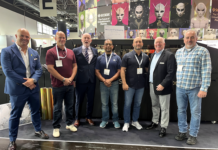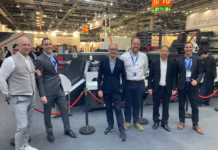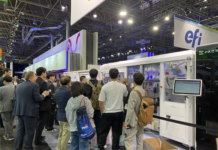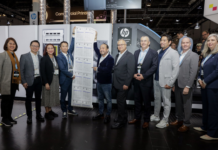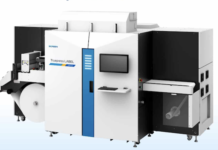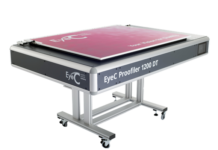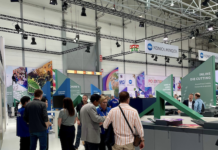The company plans to make history at drupa with the world-first Digital Glittering and Inkjet-Braille to digitally enhance print services and open new horizons in the printing industry. Along with new size versions of its popular Scodix Digital Presses, it is introducing a unique new glitter eye-catching impact with the Scodix Rainbow™ station and providing a radical new approach to the production of Braille for the blind and visually-impaired users with the new Scodix Inkjet-Braille™.
Scodix Rainbow™
The Scodix Rainbow prints glitters on selective areas, creating a sparkling, shiny experience that brings the glamour of glittering in graphic communications to digital printing. Scodix customers are able to offer the Scodix SENSE™ with and without Glittering, and create an impact that was never offered before with a digital device.
Scodix Rainbow is a dedicated station, attached to a Scodix S digital press. The Scodix Rainbow stations physical position is after the Scodix S printing engine, and before the stacker. It works in a waterfall concept, the glittering powder falls on a surface with areas covered in glue. The glittering powder then sticks to the glued area and the rest of the glittering powder is vacuumed back to the glittering container and is re-used. The glue in the Scodix case is the clear Scodix polymer.
To support Scodix customers, the Rainbow station is designed to work with standard market glittering powder available in every local area. Customers do not need to purchase the powder form Scodix. Scodix Rainbow appeals to PSPs using offset sheet-fed presses, high-end digital presses and shops using Screen printing lines that already use glittering in their workflow.
Scodix Inkjet-Braille™
With their Inkjet-Braille™ technology, Scodix is the first inkjet technology provider to offer the ability to create Braille printed materials for the commercial and packing industry. Scodix contributes towards improving the lives of the blind and the visually impaired communities in ways that many of us take for granted. Reading wedding invitations, medicine packages and magazine adverts are ordinary every day activities that can now be easily achieved and enjoyed. Furthermore, with the Scodix Inkjet-Braille™technology, they can now feel the shapes and elements that could only be described to them in words until today.
The Scodix Inkjet-Braille™ technology can be applied to academic school and childrens books. Scientific elements, shapes such as triangles, and animal forms can now be created in a raised format, allowing the blind and visually impaired communities to connect the shapes to the names through their sense reading.
Scodix Inkjet-Braille uses the Scodix UV inkjet technology to print Braille with the Scodix proprietary PolySENSE in a precise and accurate dot position based on its patented optical guidance camera based system. This solution can print up to 250 micron high dots in variable thickness, protecting the material from damage. A variety of gradations, densities and texture can be applied to the same print to easily perform both one-sided and double-sided applications.
Unlike regular Braille, the letters and shapes created through Scodix stay raised at the same height, never flatten and are easy to sense read. With the ability to imprint Braille on a variety of materials (from 135gsm papers to folding cartons up to 675gsm/30 point), Scodix Inkjet-Braille is suitable for a wide variety of commercial, marketing and packaging applications.
Scodix S Series
The company will introduce this new product line at drupa. The Scodix S74 and S52 represents two sheet size formats, 52cm wide (20) and 74cm wide (29).
The Scodix S74 and S74 PRO belong to a very exclusive digital press family of large print size sheets. This family includes the new digital CMYK presses from HP Indigo, Screen, Fuji and others – all introducing their presses at drupa. Both Scodix S74 and S74 PRO support sheet sizes of B2+ which is 520mm x 735mm and both products have an adjustable OPA system (Optical Print Alignment system, based on cameras).
The Scodix operator places the required amount of sheets in the feeder (up to 500kg/1100 pounds of materials or 2000 sheets of 135gsm/6 points can be placed in one batch), and the process from this point is fully automatic. In a front loading technique, a line of vacuum sucking cups take each sheet and load it to a belt conveyor that advances the sheet into the press (the paper is held by a vacuum system in the conveyor throughout the process). The feeder can load up to 30 point materials, as thick as 700 micron/0.7mm. The vacuum cups are the only elements that touch the material throughout the process. No hands or other things need to touch the material in the process which assures a high print quality.








